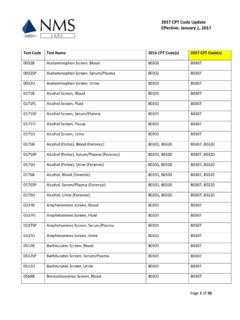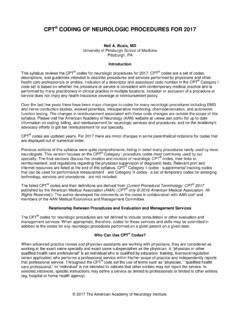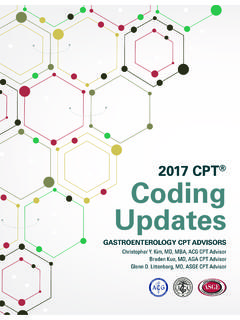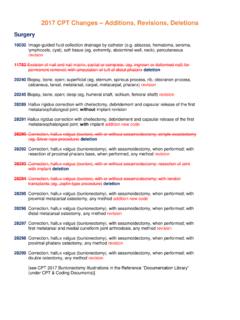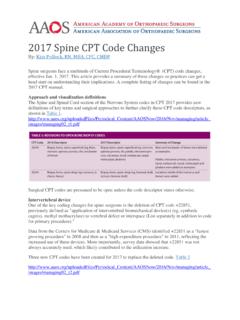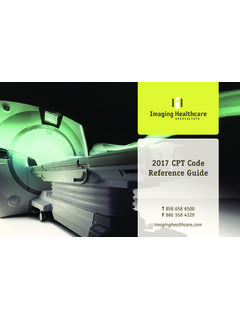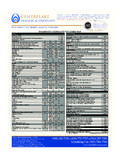Transcription of CMS Issues 2017 Final Physician Fee Schedule: What Spine ...
1 [CMS-1654-F] - Medicare Program;. Revisions to Payment Policies under the Physician Fee schedule and Other Revisions to Part B for CY 2017 ;. Medicare Advantage Bid Pricing Data Release; Medicare Advantage and Part D Medical Low Ratio Data Release;. Medicare Advantage Provider Network Requirements; Expansion of Medicare Diabetes Prevention Program Model;. CMS Issues 2017 Final Physician Fee Medicare Shared Savings Program schedule : What Spine Surgeons Should Requirements Know Table of Contents Overview Overview Spine Codes On November 2, 2016, the Centers for Medicare & Medicaid Services (CMS) o New Category I Codes effective issued a Final rule that updates payment policies, payment rates and quality 01/01/17. Data Collection: Codes with 10- and provisions for services furnished under the Medicare Physician Fee schedule 90-day Global Periods (PFS) on or after January 1, 2017 .
2 The PFS pays for services furnished by Appropriate Use Criteria Advanced physicians and other practitioners in all sites of service. These services Diagnostic Imaging Services include but are not limited to visits, surgical procedures, diagnostic tests, Next Steps therapy services, and specified preventive services. Resources To set Physician payment rates, CMS evaluates three components of medical CMS Fact Sheet services/procedures: Physician work, practice expense, and malpractice Full Text of Final Rule Final Rule Data Files expense. Each component is assigned a value also known as a relative value ISASS Letter to CMS on Proposed Rule unit (RVU). The work RVU, practice expense RVU, and malpractice RVU. are each multiplied by geographic practice cost indices (GPCI), added together, and then multiplied by a conversion factor that is updated annually.
3 The 2017 Final conversion factor is $ (the 2016 Final conversion factor was $ ). Spine Codes As part of the Final rule, CMS Issues values for new codes and codes deemed misvalued. Please see the Spine code spreadsheet for a full listing of Spine procedure RVUs and reimbursements from the 2016 Final rule compared to the 2017 . Final rule. Highlighted below are new Category I Spine codes and their corresponding values and reimbursements set to take effect January 1, 2017 . ISASS participated in the CPT and RUC processes for several of these new codes and is disappointed that despite our best efforts, CMS did not follow the RUC recommendations for several of the new codes, and instead assigned lower Final values. Please note that the reimbursement amounts contained in this document are not calculated using the geographic practice cost indices (GPCI), so your reimbursement will be slightly different than the amounts listed based on the geographic location of your practice.
4 Also note that these are the approximate reimbursement rates to the surgeon (not the facility); facility payments to hospitals and ASCs are made under separate payment systems. CMS Issues 2017 Final Physician Fee schedule : What Spine Surgeons Should Know 1. New Category I Spine Codes effective January 1, 2017 : Code Descriptor 2017 2017 Final 2017 Final 2017 Final 2017 Final Final Practice Mal- Total Reimburse- Work Expense practice RVU ment RVU RVU RVU. 22853 Insertion of interbody biomechanical device(s) (eg, $ synthetic cage, mesh) with integral anterior instrumentation for device anchoring (eg, screws, flanges) when performed to intervertebral disc space in conjunction with interbody arthrodesis, each interspace 22854 Insertion of intervertebral biomechanical device(s) (eg, $ synthetic cage, mesh) with integral anterior instrumentation for device anchoring (eg, screws, flanges) when performed to vertebral corpectomy(ies).
5 (vertebral body resection, partial or complete) defect, in conjunction with interbody arthrodesis, each contiguous defect 22859 Insertion of intervertebral biomechanical device(s) (eg, $ synthetic cage, mesh, methylmethacrylate) to intervertebral disc space or vertebral body defect without interbody arthrodesis, each contiguous defect 22867 Insertion of interlaminar/interspinous process $1, stabilization/distraction device, without fusion, including image guidance when performed, with open decompression, lumbar; single level 22868 Insertion of interlaminar/interspinous process $ stabilization/distraction device, without fusion, including image guidance when performed, with open decompression, lumbar; second level 22869 Insertion of interlaminar/interspinous process $ stabilization/distraction device, without open decompression or fusion, including image guidance when performed, lumbar; single level 22870 Insertion of interlaminar/interspinous process $ stabilization/distraction device, without open decompression or fusion, including image guidance when performed, lumbar; second level 62380 Endoscopic decompression of spinal cord, nerve Contractor Contractor Contractor Contractor *Contractor root(s), including laminotomy, partial facetectomy, Pricing Pricing Pricing Pricing Pricing foraminotomy, discectomy and/or excision of herniated intervertebral disc; 1 interspace, lumbar CMS Issues 2017 Final Physician Fee schedule : What Spine Surgeons Should Know 2.
6 (*Rather than assigning a Final value to 62380, CMS instead chose to assign contractor pricing. This means that each individual Medicare Administrative Contractor (MAC) will set its own value and make its own reimbursement determination.). In the Final rule, CMS provides the following rationale for their revised work RVU proposals: Biomechanical Device Insertion (CPT codes 22853, 22854, and 22859). The CPT Editorial Panel established three new Category I add-on codes and deleted one code to provide a more detailed description of the placement and attachment of biomechanical spinal devices. For CPT code 22853, the RUC. recommended a work RVU of For CPT codes 22854 and 22859, the RUC-recommended work RVUs are and , respectively. In reviewing the code descriptors, descriptions of work and vignettes associated with CPT codes 22854 and 22859, CMS concluded that the two procedures, in addition to having identical work time, contain many clinical similarities and do not have quantifiable differences in overall intensity.
7 Therefore, CMS proposed the RUC-recommended work RVU of for both CPT code 22854 and CPT code 22859. CMS believes that the RUC-recommended work RVU of for CPT code 22853 overestimates the work in the procedure relative to the other codes in the family. CMS. proposed a work RVU of for CPT code 22853 based a crosswalk from CPT code 37237 (Transcatheter placement of an intravascular stent(s) (except lower extremity artery(s) for occlusive disease, cervical carotid, extracranial vertebral or intrathoracic carotid, intracranial, or coronary), open or percutaneous, including radiological supervision and interpretation and including all angioplasty within the same vessel, when performed; each additional artery (List separately in addition to code for primary procedure)), which is similar in time and intensity to the work described by CPT code 22853.
8 Comment: Several commenters, including ISASS, disagreed with CMS' proposed valuation of the work RVU of for CPT code 22853 rather than the RUC-recommended work RVU of Commenters requested clarification regarding CMS' crosswalk for this new code to CPT code 37237 instead of the RUC-recommended crosswalk of CPT. code 57267. CMS Response: CMS takes many factors into consideration when valuing a work RVU for a new code. CMS notes that CPT code 57267 and CPT code 37237 have identical intraservice times and very similar total work times. CMS. notes that CPT code 37237 was most recently valued in April 2013, whereas the RUC crosswalk CPT code 57267 was last reviewed in 2004. CMS continues to believe that CPT code 37237 is an appropriate crosswalk for valuing the new CPT code 22859. Therefore, CMS finalized the proposed work RVU of for CPT code 22853.
9 Comment: CMS received several comments, including comments from ISASS, objecting to its proposed work RVU of for CPT code 22859, which is identical to the work RVU proposed by the RUC and accepted by CMS for CPT. code 22854. Commenters provided detailed descriptions of the two procedures in an effort to demonstrate the higher intensity required by CPT code 22859 compared with CPT code 22854, thereby justifying the RUC-recommended work RVU of for CPT code 22859. Several commenters expressed confusion about the descriptors for all three of the new CPT codes (CPT codes 22853, 22854, and 22859), in general, and stated their concern that the code descriptors do not clearly differentiate the work involved in furnishing the services. CMS Response: While CMS is somewhat persuaded by commenters' detailed descriptions of the two procedures and the higher intensity of work involved in furnishing CPT code 22859 compared with CPT code 22854, CMS is concerned about a substantive disagreement between the RUC and survey respondents about the intensities of work involved in furnishing the services described by these new codes.
10 The RUC and the survey respondents valued the CMS Issues 2017 Final Physician Fee schedule : What Spine Surgeons Should Know 3. relative intensities of the two codes in the reverse order. The survey results indicated a work RVU of (with 25th percentile of ) for CPT code 22854 and a work RVU of (with 25th percentile of ) for CPT code 22859. The RUC reviewed the survey results and agreed that respondents overvalued the work involved in performing CPT code 22854. The RUC-recommended work RVU for CPT code 22854, which CMS accepted as recommended, was established through a crosswalk to CPT code 37234. CMS agrees that this is an appropriate crosswalk and valuation of this service. For CPT code 22859, the RUC also believed that the survey recommended work RVU of was overvalued. The RUC recommended the 25th percentile of survey results, with a work RVU of CMS finds it difficult to reconcile the conflicting valuations by the survey and the RUC of the absolute and relative intensity of these new codes.

